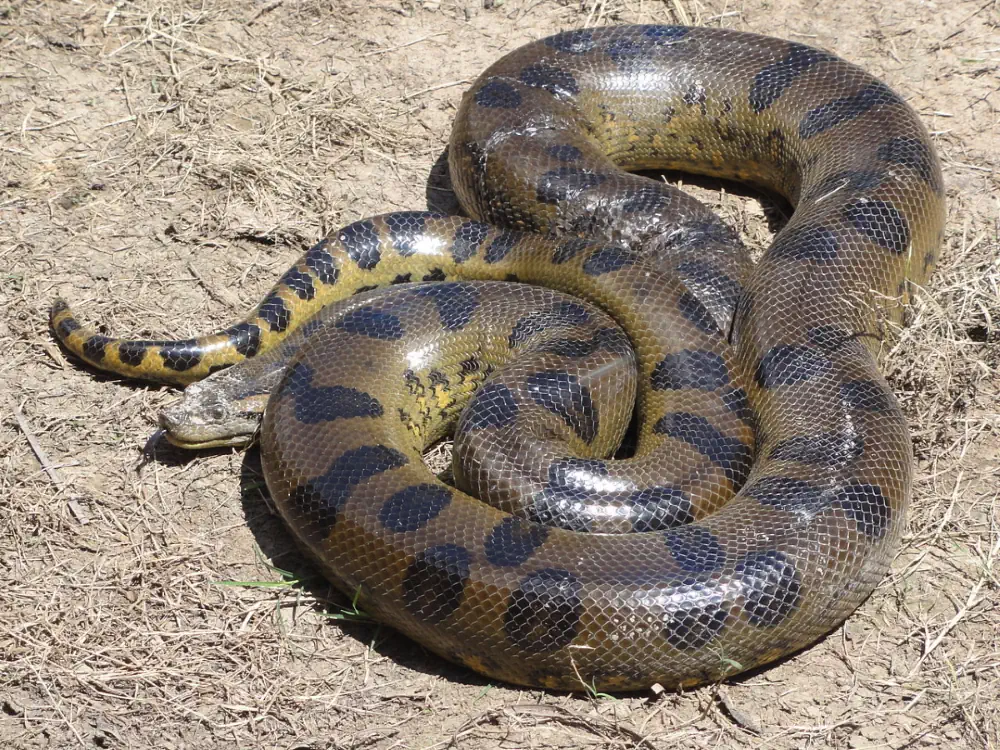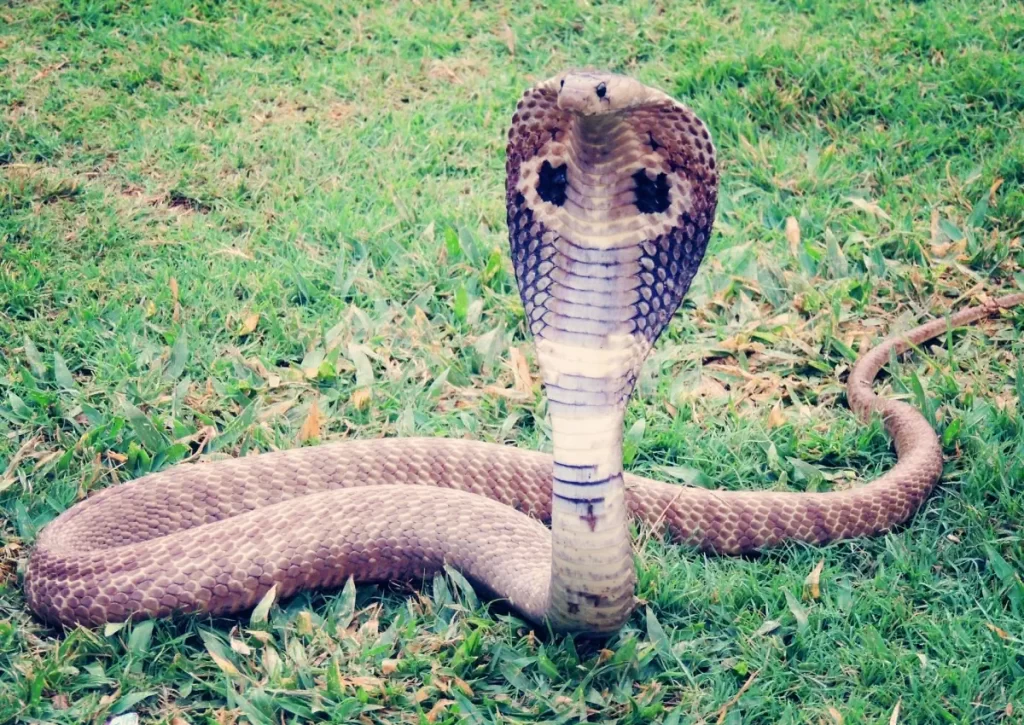Like crocodiles, snakes also suffer from a prevalence of “big fish” stories and over-exaggeration in the internet era. In fact, it is very difficult to measure how large actually a snake is, especially if it’s really big. So, how big are the longest snakes actually? Here’s the list of the largest snakes in the world.
List of the largest snakes in the world
Ana Julia: The largest snake ever recorded [7.93 meters or 26 feet]
A giant Green Northern Anaconda named “Ana Julia” was the largest snake ever recorded. The 26-foot (7.93 meters) snake weighed around 440lbs (200 kg). Green Northern Anaconda is a new Anaconda species.
Ana Julia was discovered in the Amazon Rainforest in 2024, but, unfortunately, found dead just weeks after it was discovered.
The cause of death remains under investigation amidst reports of it being shot. Dutch researcher Professor Freek Vonk, part of the discovery team, expressed deep sorrow over its death, emphasizing Ana Julia’s significant potential for contributing to its species’ future generations and biodiversity.
Despite rumors of the snake being shot, investigations continue, exploring all possibilities, including natural causes. The discovery, detailed in the journal Diversity, noted this new species diverged from the known southern green anaconda about 10 million years ago, with a 5.5% genetic difference.
Medusa: the largest snake in captivity [7.67 meters or 25 feet 2 inches]

According to the Guinness World Records Book, at 7.67 meters (25 feet 2 inches) long, Medusa, a Reticulated Python owned by Full Moon Productions in Kansas City, Missouri, USA is the longest snake ever in captivity.
The 8-year-old (as of 2015), 158.8 kilograms (350-pound) reptile is primarily kept coiled up in a nook in a haunted house attraction (The Edge of Hell) with its cavernous turn-of-the-century brick warehouse. Medusa’s primary diet consists of a combination of rabbits, hogs, and deer, served to her every two weeks.

Unofficial: Python caught in Malaysia could be the longest snake ever recorded

In April 2016, a huge python was caught on a construction site in Penang Island, Malaysia. According to the Malaysia Civil Defence Department authorities, it was 8 meters (26 feet and 2.96 inches) in length and about 250 kg (551.15 lb) in weight.
It was longer and heavier than Medusa if these measurements were correct (Guinness World Records Book still recognizes Medusa as the longest snake ever in captivity). It was a pregnant female. Unfortunately, the snake died three days after being captured. She first gave birth, then died.
Largest snake species (extant)
The longest snake species in the world: Reticulated python (Python reticulatus)

The longest snake in captivity, Medusa is a Python reticulatus, also known as the (Asiatic) reticulated python, a species of python found in Southeast Asia. Adults can grow to 6.95 m (22.8 ft) in length (so Medusa is an exceptionally long specimen) but normally grow to an average of 3-6 meters (9.8-19.7 feet).
It is a great swimmer, has been reported far out at sea, and has colonized many small islands within its range. The specific name,
Like all pythons, they are normally not considered dangerous to humans. Although large specimens are powerful enough to kill an adult human, attacks are only occasionally reported. Despite this, Python reticulatus has been responsible for several human fatalities, in both the wild and captivity.
The heaviest snake in the world: Green Anaconda (Eunectes murinus)

Eunectes murinus (green anaconda) is the largest, heaviest snake species. It is also the second-longest (behind its cousin, the reticulated python)
Its Latin name is derived from the Greek ευνήκτης meaning “good swimmer” and the Latin
A member of the boa family, the green anaconda can reach 5.21 meters (17.1 feet) long. More typical mature specimens reportedly can range up to 5 meters (16.4 feet), with the females, at around a mean length of 4.6 meters (15.1 feet), being generally much larger in adulthood than the males, which averages around 3 m (9.8 feet).
Weights are less well studied, though they will reportedly range from 30 to 70 kg (66 to 154 lb) in an average-range adult. It is the largest snake native to the Americas.
Although it is slightly shorter than the Reticulated python, it is far more robust: the bulk of a 4.5-meter green anaconda would be comparable to a 7.4-meter reticulated python (on average, the record holder Medusa above is an exception).
Reports of anacondas 35-40 feet (10.6-12.1 meters) or even longer also exist, but such claims need to be regarded with caution, as no specimens of such lengths have ever been deposited in a museum and hard evidence is lacking. A $50,000 cash reward is offered for anyone who can catch an anaconda 30 ft (9.1 m) or longer, but the prize has not been claimed yet.
The longest (and heaviest) verified specimen encountered by Dr. Jesús Antonio Rivas, who had examined thousands of anacondas, was a female measuring 5.21 meters (17.09 ft) long and weighing 97.5 kg (215 lb).
The Longest Venomous Snake: King Cobra (Ophiophagus hannah)
King Cobra (scientific name: Ophiophagus hannah) is the longest venomous snake in the world. The longest specimen ever found was measured at 5.85 meters (19.2 feet) long. But, on average, they have a length of 3.18 to 4 meters (10.4 to 13.1 feet).
Large males can weigh up to 10 kg (22 lbs) while females are about 5 kg (11 lbs) on average.
King Kobra is native to jungles in Southern and Southeast Asia.

The Longest Sea Snake: The Yellow Sea Snake
The venomous yellow sea snake (scientific name: Hydrophis spiralis) is the longest species of sea snake. They can be as long as 3.0 meters (9.8 feet). Most specimens do not exceed 2.0 meters, though.
Largest snake species (extinct)
Gigantophis

Gigantophis garstini was a giant prehistoric snake that may have measured more than 10 meters (33 feet), larger than any living species of snake. Before Titanoboa was discovered in Colombia in 2002, it was regarded as the largest snake ever. Gigantophis lived approximately 40 million years ago in the northern Sahara, where Egypt and Algeria are now located.
The snake was named after Egyptian Under Secretary of State for Public Works, William Garstin. The species is known to scientists only from a small number of fossils, mostly vertebrae.
Titanoboa: the largest snake ever lived

Titanoboa, meaning “titanic boa”, is an extinct genus of snake that lived approximately 60-58 million years ago, during the Paleocene epoch, a 10-million-year period immediately following the dinosaur extinction event. The only known species is Titanoboa cerrejonensis, the largest, longest, and heaviest snake ever discovered.
By comparing the sizes and shapes of its fossilized vertebrae to those of extant snakes, researchers estimated that the largest individuals of Titanoboa cerrejonensis found had a total length of around 12.8 m (42 ft) and weighed about 1,135 kg (2,500 lb; 1.1 long tons), which supplanted the previous record holder, Gigantophis.
Jason Head, then working at the University of Toronto and Indiana University paleontologist P. David Polly for two years had been building a mathematical model of a snake spinal column based on living species.
By examining these joints, ridges, and knobs, and describing individual vertebrae as a set of coordinate points on a graph, Head and Polly created a template for all snakes.
Over the course of evolution, “snakes get bigger by adding more vertebrae,” Head said, and there can be as many as 300 vertebrae in the spinal column of a modern python, boa, or anaconda. “But the big ones get more vertebrae only up to a point, then the vertebrae just get bigger.”
After developing coordinates for individual Titanoboa vertebrae, Head and Polly used the model to position them in their correct spinal location and determine Titanoboa’s length.
The team published its first results in Nature in early 2009, saying Titanoboa was between 42 feet and 49 feet (12.8-14.9 meters) long, with a mean weight of 2,500 pounds (1,134 kg). The Cerrejón vertebrae were all of comparable size even though they were from different animals. With Titanoboa, enormous was the rule, not the exception.
Several researchers disagreed with the above estimate. For example, a 2009 study in the journal Nature applying the mathematical model used in the above study to an ancient lizard fossil from temperate Australia predicts that lizards currently living in tropical areas should be capable of reaching 33 feet, which is obviously not the case.
In another critique published in the same journal, Mark Denny, a specialist in biomechanics, noted that the snake was so large and was producing so much metabolic heat that the ambient temperature must have been four to six degrees cooler than the current estimate, or the snake would have overheated.
Why it’s so hard to measure large snakes?
The remote location of the big snakes’ habitat has historically made locating, capturing, and returning specimens difficult.
A large snake’s skin can stretch substantially, increasing its size by more than 50% if stretched during the tanning process. Reports without physical proof are almost always dubious (in fact, simply false) from non-scientists: such individuals may at worst be more interested in promoting themselves or telling a good tale, or at the least may not be sufficiently trained in proper measurement methods.
Observational reports of animals that were not captured are even more dubious, as even trained scientists often substantially overestimate the size of big snakes prior to capture. According to the Guinness Book of World Records, this species has been perhaps subject to the most extreme size exaggerations of any living animal.
It is also difficult to argue a maximum possible or plausible size because snakes are known to continue to grow throughout their lives. Older reports, in particular, could include individuals which, in times of less pressure from humans, lived longer lives and thus reached greater sizes.
Numerous historical accounts of the big snakes are reported, often of improbable sizes. Several zoologists (notably Henry Walter Bates and Alfred Russel Wallace, among others) note rumors of snakes beyond 30 or 40 feet (9-12 meters) long, but in each case, their direct observations were limited to snakes of approximately 20 feet (6.1 meters) in length.
To prove the point of overestimating, in Guyana in 1937, zoologist Alpheus Hyatt Verrill asked the expedition team he was with to estimate the length of a large, curled-up anaconda on a rock. The team’s guesses ran from 6.1 to 18.3 meters (20.0 to 60.0 feet); when measured, this specimen was found to be 5.9 meters (19.4 feet).
Some “huge snake” hoaxes
10-meter (33-feet) Brazil Anaconda
According to some websites, a giant 10-meter (33 feet) long anaconda was found at a construction site in Altamira, Pará in northern Brazil. The monster snake is also 1 meter (3.2 feet) in diameter and weighs 400 kg (881.849 lbs).
If it were true, it would be the largest snake ever recorded in history. But come on, an anaconda almost as big as Titanoboa? It seems the snake hasn’t been properly authenticated, and it is much larger than any other accurately reported sighting. Note that they used the forced perspective technique in the photo below.

The hoax was started by some tabloid papers’ websites like dailymail.co.uk, thesun.co.uk, mirror.co.uk, dailystar.co.uk, etc. They posted the video above and filled the internet with anacondas 10 meters and 400 kg.
You can read the whole story of the hoax on the Ellinika hoaxes website(you may want to translate the page into English). According to the site, the hoax was originally produced by e-farsas.com, which managed to fool the whole world.
The company that manufactures the dam also noticed that the video is not taken in the place where Belo Monte Dam is being constructed.
50 feet (15 meters) anaconda in the Xingu River, Brazil?
According to some new sites, a 50 feet (15 meters) anaconda has been seen in the Xingu River, Brazil. There’s also a video. But that video is edited and distorted. Here’s the real footage and the explanation of a biologist (video in Spanish).
Sources
- “World’s largest snake Ana Julia found dead in Amazon rainforest just weeks after it was discovered” on the MSN website
- Eunectes murinus (green anaconda) on Wikipedia
- Green Anaconda on National Geographic
- Longest snake ever in captivity slithers into Guinness World Records 2013
- Python reticulatus (reticulated python) on Wikipedia
- Gigantophis on Wikipedia
- Gigantophis on Snake Facts
- How Titanoboa, the 40-Foot-Long Snake, Was Found in Smithsonian Magazine
- King Cobra on Wikipedia
- Hydrophis spiralis on Wikipedia
- How Many Elephants are Left in the World in 2025? - August 17, 2025
- Moon Landings: All-Time List [1966-2025] - February 2, 2025
- What Is Max-Q and Why Is It Important During Rocket Launches? - January 16, 2025


2 replies on “Largest Snakes in the World [No BS list!]”
The last section has a mistake, the critique that Head et al. (2009) received was about the temperature they estimated for the time Titanoboa lived, it was not about their size estimate.
Titanoboa is the biggest snake ever